Radio
Introduction
This page introduces radio as a practical and reliable communications infrastructure for use in a situations and events where Internet access and mobile communications are not available.
The Internet and mobile networking are complex infrastructures dependent on a stack of technology for their function, from internet exchanges to routing and switching hardware, submarine cables, base stations and their antennae and a stable power grid. This complexity introduces multiple points of vulnerability. For instance, a flood could damage a power station, causing a black out that results in no Internet access at home nor mobile data, texts or calls via the cellular network.
It is here that radio offers a valuable fallback technology for not only receiving critical status updates and information from local authorities and other communities, but also can allow for transmissions from your own community or group that can help you reach others and get needed assistance.
AM(MW)/FM radio reception
In an emergency where critical infrastructure is experiencing outage, local information will almost always be broadcast over AM (also referred to as Medium Wave) and/or FM. It is for this reason, at the least, a simple AM(MW)/FM radio with charged batteries and spares should be acquired and stored in an accessible place. They can usually be bought very cheaply.
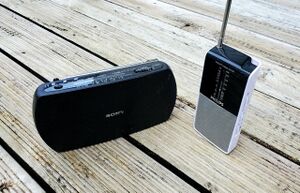
It is good to buy am AM(MW)/FM radio with a mini-jack socket and extendable antenna. The mini-jack socket allows for plugging in headphones which can be useful when reception quality is poor. The extendable antenna can greatly aid in finding and receiving a broadcast.
Small radios such as these can be put into a backpack or 'go bag', alongside a spare set of batteries. Rechargeable batteries should be used where possible. It can be a good idea to waterproof your radio by putting it in a quality zip-lock bag, alongside spare batteries held together with a rubber band or tape. Be sure you have tested it and have learned how to use it before you do.
If you are caught out without a radio and have access to a vehicle, it very likely has a built-in AM(MW)/FM radio. Note that AM broadcasts travel over vastly longer distances than FM, and so it is important to be aware of this in relation to your geographical context. As always the best reception with radio is line-of-sight. While it is rare we can see the antenna(e) we are receiving a broadcast from, getting to a position of altitude away from RF (radio-frequency) occlusions like buildings and hills can make all the difference in reception.
Walkie-talkies
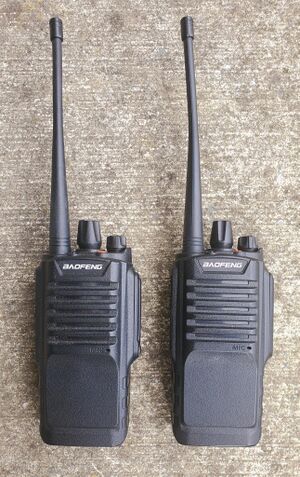
Unlike AM(MW)/FM radios detailed above, walkie-talkies are both broadcast station and receiver, and so known as 'two-way' radios. The range of a modern walkie-talkie is anything from a few hundred meters in a city and in dense vegetation, to many kilometers when used on a peak or high rooftop. This communication tool can be especially invaluable when you are in a group and need to split up, staying in contact and relaying information.
Walkie-talkies operate on license-free broadcast frequency ranges in the UHF (Ultra High Frequency) band respective to the region the walkie talkie is purchased within. In the EU the allocation is known PMR446 (Private Mobile Radio, 446 MHz)[1], whereas in the US it is typically the Family Radio Service (FRS)[2] or GMRS[3], and in Australia UHF CB[4].
Regardless, if you are in a region using 2 or more walkie-talkies operating on unlicensed bands, they will still function. Typically walkie-talkies include a channel selector for selecting a pre-agreed channel to operate on. This selector is either a button or dial. It is important to agree on a channel to use before splitting up your group and using the walkie-talkies. Some walkie talkies also include an AM/FM radio scanner, allowing the operator to quickly find and tune into a local radio station. Some even include NOAA weather radio receivers.
When selecting a walkie-talkie it is good to ensure it has a high IPX water rating, is durable, has a 'squelch' function (allows for 'cleaning' up a noisy signal to hear it better), good battery life and has at least 3W of power. Importantly, some walkie-talkies can only be charged in a special charging dock, and so if you choose a walkie-talkie of this sort it is important that it has removable batteries such that you can bring pre-charged batteries with you. If not, it is good to get walkie-talkies that take AA batteries, that you can recharge in a standard battery charger, one of which may include a portable solar charger.
2-way communication guide
If you are needing to split up your group, pre-arrange a signals plan such that group parties are not burning through batteries waiting for status updates throughout the period you are apart. That signals plan involves both agreeing on a channel and times or time-windows to be in contact. If the time is known to both parties throughout, specific times or windows of time can be agreed in advance. For instance, on a day long expedition beginning in the morning the expedition party may agree to send status updates at 10:30, noon, 14:30 and between 16:00 and 18:00 as expected range of arrival time. If clocks are not at hand for both parties, sun position will need to be used.
In the event there is a basecamp or base with more than 1 other party working remotely, then all contact should go through basecamp rather than between parties directly. Important information is best written down first for clarity, and to minimise time spent using the handsets so preserving battery life.
Use the RSVP guide for 2-way communication [5]:
- Rhythm - Speak at an even pace
- Speed - Talk slowly
- Volume - Speak softly
- Pitch - Speak at a higher pitch than normal and use the phonetic alphabet when spelling out names
While not always easy, try to time your status updates from a position of high altitude. Signals will always be weaker in gullies, valleys, within dense foliage and in between tall buildings.
Random Wire Antenna
While far more efficient antenna designs exist, when long range reception is urgently needed, a simple but powerful antenna can be quickly built using shielded or un-shielded copper wire. Such wire can be a single core of common electrical wire used to wire a home, or any copper wire thick enough to withstand the strain of being strung taut between two points. Of all the wires, copper-clad steel wire between 1.6 to 2.0 mm is best however [6].
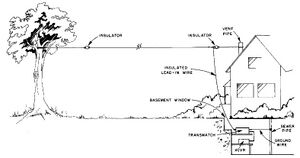
The length of a random wire antenna should correspond to the bands you wish to listen to, and should be at minimum 1/4 of the wavelength of the band at which you wish to receive.
Random wire antenna for AM/MW reception
In a disaster situation with no access to mobile data nor the Internet, and a handheld radio does not provide sufficient reception or is unavailable, AM/MW radio is a good first option. If you are wanting to listen for local shortwave (AM/MW) broadcasts, a 5.8M length of wire will give you opportunity to listen to many stations within the popular range of 505 kHz at 13.2475 MHz and from stations further away than can typically be reached with a small handheld radio (as shown above). This is probably your best option in an emergency situation with little at hand.
A common configuration for random wire antennae is that of a wire suspended between a home (or shelter) and a tree or adjacent structure. A loop can be made in the wire, twisted tight, and paracord or rope used to fasten it to each end. It is important that the wire is electrically insulated from the structures it is tethered to. Paracord or rope can be covered in an insulating plastic at the points of contact with the wire. If just using wire to affix to the structures, ceramic insulators can be added inline. In the absence of insulators, a ceramic cup with a sturdy handle can be used, with each portion of wire twisted to each end of the handle and the cup horizontal.
Random wire antennas are ever at risk of electrical storms, and so such an antenna should be electrically grounded. For this exposed metal plumping pipe can be used, or a steel stake driven deep into the ground.
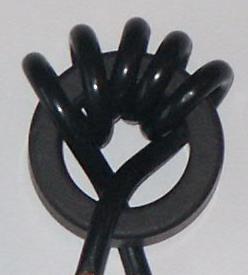
At the receiving end of the random wire antenna, a balun is ideally used. A balun 'balances' an unbalanced line, significantly improving reception quality and mitigating for many Standing Wave Ratio (SWR) challenges, typical of long lines of wire used in a radio context[7]. Baluns can be made using a simple toroidal core commonly harvested from electronics at hand, or a professional balun can be purchased suitable for the project.
Random wire antennae for hobby and amateur radio bands
During emergencies hobby and amateur radio (HAM) bands can be a source of valuable information. Radio operators operating in their homes or 'radio shack' may send broadcasts on popular 20M, 40M and 80M bands. These are long-distance bands, sometimes covering hundreds or thousands of kilometers, and so this should be kept in context when seeking information. It is also important to beware the operators of these bands are not necessarily providing authoritative situational status information. For this reason, AM/MW bands should be the preferred choice for reception when mobile data and Internet connectivity is not possible.
If you are wanting to listen to broadcasts from popular amateur radio bands, which have far larger wavelengths (like 40M, 80M), you can try any very long wire you can get your hand on. Very long wires can allow for tuning across several bands, as the wire will include 1/4, 1/2 and perhaps even full wavelength representations. Using any long wire without a balun will often result in reception suffering from Standing Wave Ratio (SWR) interference due to differences in impedance between the antenna itself and the feedline to the receiver [8]. If you are without a balun, you can carefully select a wire for minimum interference. Physicists have studied random wire electromagnetic fields in relation to the SWR phenomenon, and with the aid of computer modeling have determined ideal lengths for minimal interference. J. C. Sprott, a physicist at University of Wisconsin, USA, has calculated the optimal lengths for reception of the most widely used bands of 1.8-2, 3.5-4, 7-7.3, 10.1-10.15, 14-14.350, 18.068-18.168, 21-21.45, 24.89-24.99, and 28-29.7 MHz[9]. As an example, a good wire length for broadcasts around 100kHz would be approximately 15 meters (49 feet).
Wavelength calculation

If you know what frequency you need to tune into, you can calculate the full wavelength and build an antenna to match. The wavelength calculation is as follows:
Here, 'v' is called the phase speed (magnitude of the phase velocity) of the wave and 'f' is the wave's frequency[10]. In the context of radio, 'v' is the speed of light, or 3×108 m/s (specifically 299,792,458 m/s). For instance, if the desired emergency broadcast station was at 1650kHz, the full wavelength would be 181.69m, and so a 1/4 wave of 45.42 meter (149 feet) or 1/2 wave antenna of 90.84 meter (298 feet) could be built.
Receivers, transceivers and tuners
To work with specialist and custom antennae a receiver will be needed. Unless the antenna is built with precision to listen to a particular signal, a tuner will be needed. If broadcast is also desired, a transmitter will be required. In radio terminology, a device that both transmits (TX) and receives (RX) is a 'transceiver.
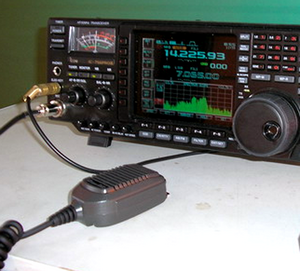
Dedicated all-in-one transceivers can vary greatly in price and features, and depending on the region the operator is in, are bound to local broadcasting laws. Typically a HAM (Hobby and Amateur Radio) license is required to operate them.
An all-in-one transceiver is recommended for those with little technical knowledge. Most can be quickly learned reading their respective technical documentation. A more technical but in some cases less inexpensive option is discussed below.
Software Defined Radio
In recent years, Software Defined Radio (SDR) has emerged as a practical and accessible alternative to dedicated hardware radio transceivers and receivers. Software Defined Radio implements a software interface to tunable radio hardware, such that reception and broadcasts can be done and processed entirely in software. This gives great flexibility to the operator, even so far as allowing for them to build their own tuners, signal de-modulators and broadcasting stations.
Software Defined Radio is a large topic, and will not be covered in depth here. Should the reader be interested in exploring building transceivers in an SDR context, both the BladeRF and HackRF are interesting hardware options to look at. A comprehensive list of SDRs can be found here[11]. SDRs are typically interfaced with GNUradio or another software radio programming environment[12]. Every feature and facet of a modern dedicated hardware transceiver can be implemented in software on a laptop or workstation.
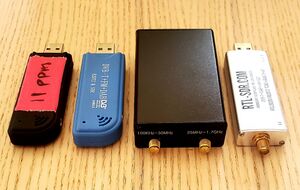
An inexpensive option for those wishing to build a quality receiver for their long-range antenna project is working with RTL-SDR devices and compatible tuners. RTL-SDR devices are low-cost digital video tuner (DVB-T) USB sticks using the Realtek RTL2832U controller that can be repurposed for receiving a broad spectrum of radio signal[13]. Some RTL-SDR models will provide reception from 500 kHz up to 1.75 GHz. For those wishing to work with lower signals, for instance in the MW, an 'upconverter' can be used. A popular upconverter is the Nooelec 'Ham it up'.
The RTL-SDR project is maintained by a radio enthusiast group called Osmocom[14]. RTL-SDR drivers exist for GNU/Linux, Windows and OS X, and can be tuned with several different popular interfaces. One of them, which is recommended for beginners, is the cross platform visual tuner and de-modulator GQRX[15].
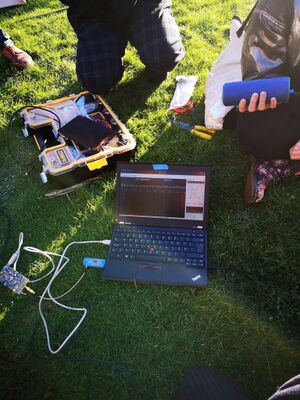
When working with RTL-SDR devices it is important to use a reference tone to determine the amount of 'clock shift' (in parts-per-million) that the device in use has, and shift it using your chosen tool before use. This is due to the lower quality of the clock (used to tune) on these devices. They will differ from device to device.
Citations
- ↑ https://en.wikipedia.org/wiki/PMR446
- ↑ https://en.wikipedia.org/wiki/Family_Radio_Service
- ↑ https://www.fcc.gov/wireless/bureau-divisions/mobility-division/general-mobile-radio-service-gmrs
- ↑ https://en.wikipedia.org/wiki/UHF_CB
- ↑ SAS Survival Handbook (3rd edition), J. Wiseman, p24
- ↑ https://en.wikipedia.org/wiki/Random_wire_antenna
- ↑ https://en.wikipedia.org/wiki/Balun
- ↑ https://en.wikipedia.org/wiki/Standing_wave_ratio#Practical_implications_of_SWR
- ↑ https://sprott.physics.wisc.edu/technote/randwire.htm
- ↑ https://en.wikipedia.org/wiki/Wavelength
- ↑ https://en.wikipedia.org/wiki/List_of_software-defined_radios
- ↑ https://en.wikipedia.org/wiki/GNU_Radio
- ↑ https://www.rtl-sdr.com/
- ↑ https://en.wikipedia.org/wiki/Osmocom
- ↑ https://gqrx.dk/